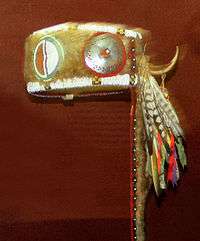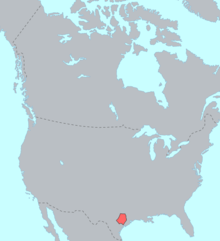Tonkawa
|
Seal of the Tonkawa Tribe of Oklahoma | |
| Total population | |
|---|---|
| 611[1] | |
| Regions with significant populations | |
|
| |
| Languages | |
| English, Tonkawa language | |
| Religion | |
| Christianity, Native American Church, traditional tribal religions | |
| Related ethnic groups | |
| Wichita, Waco, Tawakoni, Kichai, Guichita |
The Tonkawa are a Native American tribe indigenous to present-day Oklahoma and Texas. They once spoke the now-extinct Tonkawa language; it is believed to have been a language isolate not related to any other indigenous tongues. Today, many descendants are enrolled in the federally recognized tribe Tonkawa Tribe of Indians of Oklahoma.
In the 15th century, the Tonkawa tribe probably numbered around 5,000, with their numbers diminishing to around 1,600 by the late 17th century due to fatalities from new infectious diseases and warring with other tribes, most notably the Apache. By 1921, only 34 tribal members remained. Their numbers have since recovered to close to 700 in the early 21st century. Most live in Oklahoma.[1]
Name
The Tonkawa's autonym is Tickanwa•tic (meaning "real people"). The name Tonkawa is derived from the Waco tribal word, Tonkaweya, meaning "they all stay together".[2]
Economy
The Tonkawa tribe operates a number of businesses which have an annual economic impact of over $10,860,657.[1] Along with several smoke shops, the tribe runs both the Tonkawa Indian Casino located in Tonkawa, Oklahoma, and the Native Lights Casino in Newkirk, Oklahoma.[3]
Events

The annual Tonkawa Powwow is held annually on the last weekend in June to commemorate the end of the tribe's own Trail of Tears when the tribe was forcefully removed and relocated from its traditional lands to present-day Oklahoma.[4]
History
Scholars used to think the Tonkawa originated in Central Texas. Recent research, however, has shown that the tribe inhabited northeastern Oklahoma in 1601.[5] By 1700, the stronger and more aggressive Apache had pushed the Tonkawa south to the Red River which forms the border between current-day Oklahoma and Texas. Tonkawa had a penchant for cannibalism, which made them unpopular with other Native American groups and the new Texans.[6]
In the 1740s, some Tonkawa were involved with the Yojuanes and others as settlers in the San Gabriel Missions of Texas along the San Gabriel River.[7]
In 1758, the Tonkawa along with allied Bidais, Caddos, Wichitas, Comanches, and Yojuanes went to attack the Lipan Apache in the vicinity of Mission Santa Cruz de San Sabá, which they destroyed.[8]

The tribe continued their southern migration into Texas and northern Mexico, where they allied with the Lipan Apache.[5][9]
In 1824, the Tonkawa entered into a treaty with Stephen F. Austin to protect Anglo-American immigrants against the Comanche. Austin was at that time an agent recruiting immigrants to settle in the Mexican state of Coahuila y Texas.[10] (The Republic of Texas declared its independence in 1836 and merged with the United States in 1846.) In 1840 at the Battle of Plum Creek and again in 1858 at the Battle of Little Robe Creek, the Tonkawa fought alongside the Texas Rangers against the Comanche.[11]
Due to Tonkawa loyalty to the Confederacy during the American Civil War, pro-Union tribes fought against them in 1862 in what is now known as the Tonkawa Massacre, killing 133 of the remaining 309 Tonkawa.[12] The surviving Tonkawa were removed to Indian Territory and were resettled in the area of present-day Kay County, Oklahoma.[2]
The Tonkawa fought alongside the 4th US Cavalry in its battles with the Comanche during both the 1871 Battle of Blanco Canyon and the 1872 Battle of the North Fork of the Red River.[4]
In October 1884, the federal government relocated more than 90 Tonkawa from their lands on the Brazos River Reservation in Texas to the Indian Territory. During the train journey which began in Cisco, Texas, a Tonkawa baby was born en route and was given the name "Railroad Cisco".[4]
On October 21, 1891, the tribe signed an agreement with the Cherokee Commission to accept individual allotments of land.[13]
Tonkawa groups
The Tonkawa were actually made up of various groups, many of which are no longer known by name. These groups are generally counted as Tonkawa:
- Awash
- Choyopan
- Haiwal
- Hatchuknni
- Kwesh
- Mayeye
- Nilhailai
- Ninchopen
- Pakani
- Pakhalateh
- Sanukh
- Talpkweyu
- Titskanwaticha
See also
References
- 1 2 3 2011 Oklahoma Indian Nations Pocket Pictorial Directory. Oklahoma Indian Affairs Commission. 2011: 36. Retrieved 8 Feb 2012.
- 1 2 May, Jon D. Encyclopedia of Oklahoma History and Culture. "Tonkawa." Retrieved May 30, 2013.
- ↑ Oklahoma Indian Casinos: Kay County. 50 Nations. (retrieved 8 Feb 2009)
- 1 2 3 Tonkawa Tribal History. The Tonkawa Tribe. (retrieved 7 Feb 2009)
- 1 2 May, Jon D. "Tonkawa", Encyclopedia of Oklahoma History & Culture, Tulsa: Oklahoma Historical Society (retrieved 8 Feb 2009)
- ↑ Jones, William K. 1969. “Notes on the History and Material Culture of the Tonkawa Indians.” Smithsonian Contributions to Anthropology. Vol. 2, No. 5.
- ↑ Gary Clayton Anderson, The Indian Southwest, 1580-1830: Ethnogenesis and Reinvention (Norman: University of Oklahoma Press, 1999) p. 85
- ↑ Anderson, The Indian Southwest, p. 89
- ↑ Walker, Jeff (2007-11-16). "Chief returns » Local News » San Marcos Record, San Marcos, TX". Sanmarcosrecord.com. Retrieved 2011-11-11.
- ↑ "The Tonkawa Story". Manataka.org. Retrieved 2011-11-11.
- ↑ Gwynne, S. C. (2011). Empire of the Summer Moon: Quanah Parker and the Rise and Fall of the Comanches, the Most Powerful Indian Tribe in American History. Scribner. pp. 7, 211. ISBN 1-4165-9106-0.
- ↑ "Bell County Network for Educational Technology". Bellnetweb.brc.tamus.edu. 2008-09-30. Retrieved 2011-11-11.
- ↑ Deloria Jr., Vine J; DeMaille, Raymond J (1999). Documents of American Indian Diplomacy Treaties, Agreements, and Conventions, 1775-1979. University of Oklahoma Press. pp. 346–348. ISBN 978-0-8061-3118-4.
Further reading
- Himmel, Kelly F. (1999). The conquest of the Karankawas and the Tonkawas, 1821-1859. College Station, Texas: Texas A&M University Press. ISBN 978-0-89096-867-3.
External links
| Wikimedia Commons has media related to Tonkawa. |
- Official website
- Jeffrey D. Carlisle: Tonkawa Indians from the Handbook of Texas Online
